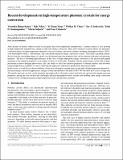Recent developments in high-temperature photonic crystals for energy conversion
Author(s)
Rinnerbauer, Veronika; Ndao, Sidy; Yeng, YiXiang; Senkevich, Jay; Soljacic, Marin; Chan, Walker R; Joannopoulos, John; Celanovic, Ivan L.; ... Show more Show less
Downloadsoljaac crystals.pdf (2.095Mb)
OPEN_ACCESS_POLICY
Open Access Policy
Creative Commons Attribution-Noncommercial-Share Alike
Terms of use
Metadata
Show full item recordAbstract
After decades of intense studies focused on cryogenic and room temperature nanophotonics, scientific interest is also growing in high-temperature nanophotonics aimed at solid-state energy conversion. These latest extensive research efforts are spurred by a renewed interest in high temperature thermal-to-electrical energy conversion schemes including thermophotovoltaics (TPV), solar–thermophotovoltaics, solar–thermal, and solar–thermochemical energy conversion systems. This field is profiting tremendously from the outstanding degree of control over the thermal emission properties that can be achieved with nanoscale photonic materials. The key to obtaining high efficiency in this class of high temperature energy conversion is the spectral and angular matching of the radiation properties of an emitter to those of an absorber. Together with the achievements in the field of high-performance narrow bandgap photovoltaic cells, the ability to tailor the radiation properties of thermal emitters and absorbers using nanophotonics facilitates a route to achieving the impressive efficiencies predicted by theoretical studies. In this review, we will discuss the possibilities of emission tailoring by nanophotonics in the light of high temperature thermal-to-electrical energy conversion applications, and give a brief introduction to the field of TPV. We will show how a class of large area 2D metallic photonic crystals can be designed and employed to efficiently control and tailor the spectral and angular emission properties, paving the way towards new and highly efficient thermophotovoltaic systems and enabling other energy conversion schemes based on high-performance high-temperature nanoscale photonic materials.
Date issued
2012-08Department
Massachusetts Institute of Technology. Institute for Soldier Nanotechnologies; Massachusetts Institute of Technology. Department of Chemical Engineering; Massachusetts Institute of Technology. Department of Electrical Engineering and Computer Science; Massachusetts Institute of Technology. Department of Physics; Massachusetts Institute of Technology. Research Laboratory of ElectronicsJournal
Energy and Environmental Science
Publisher
Royal Society of Chemistry, The
Citation
Rinnerbauer, Veronika, Sidy Ndao, Yi Xiang Yeng, Walker R. Chan, Jay J. Senkevich, John D. Joannopoulos, Marin Soljačić, and Ivan Celanovic. “Recent developments in high-temperature photonic crystals for energy conversion.” Energy & Environmental Science 5, no. 10 (2012): 8815.
Version: Author's final manuscript
ISSN
1754-5692
1754-5706